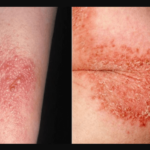The outermost layer of your skin, the epidermis, is frequently changing. As skin cells travel from the lower layers of the epidermis to the surface, they’ll ultimately fall off. The process is known as skin cell turnover or natural exfoliation, where cells die and shed off to reveal more glowing younger skin. So, how long does it take to shed your skin?
It takes about 4 to 6 weeks for your skin to shed – to complete the cycle from new skin cells to shed off your body. The time it takes will vary based on your age, your health, and your skincare routine. Exfoliation helps to speed up skin shedding and prevent a build-up of dead skin cells.
You may also be wondering why you don’t see these skin cells lying around. Well, the reason for that is because once they leave your body, they turn into dust. It’s also estimated that most of what you vacuum from your carpet is stray skin flakes. So basically, every time you vacuum your home, you’re sucking up a piece of yourself and others who live with you.
Read on to learn more about how long it takes to shed your skin, also how you can encourage the process to prevent a build-up of dead skin cells.
How Long Does It Take to Shed Your Skin?
- You shed off millions of dead skin cells each day. Don’t worry, they don’t just fall off at once, but instead, you’ll leave a trail of them wherever you go.
- Every minute, you’re leaving around 30,000 or more skin flakes or scales. They’re getting on your mobile phone or laptop as we speak, and even on your outfit.
- Each year you’re losing around 1 to 1.5 pounds of your skin.
- By the time you’re 70 years old, you’d most likely shed off around 105 pounds of your skin.
- You’ll shed and renew your outer skin cells about every 27 days, which means you’ll have almost 1,000 new skins in your lifetime.
Your skin cells are held together by desmosomes, a type of protein rivets. And when the right time comes, the enzymes in your skin will degrade these desmosomes allowing your cells to shed and separate one by one.
The skin you shed every hour is between 0.03 to 0.09 grams every hour. It may sound like nothing, but it’ll add up to around 35 kilograms throughout your lifetime, which is approximately 50% of your body weight. The majority of the skin you shed is similar to tiny flakes. So how long does it take to shed your skin?
Your skin will regularly change throughout your entire life and will renew itself roughly every 27 days. The skin cell regeneration cycle often varies for people between 4 and 6 weeks. The speed by which your skin renews or sheds will slow down as you age. So keep this in mind in terms of your daily skincare routine.
When you have very dry skin, these enzymes that dissolve desmosomes will not function properly. This, in turn, will lead to clusters of cells shedding together rather than single cells that invisibly shed. You may have seen this on your own skin if you have dry skin or a more serious condition like eczema or psoriasis. The dead skins will bunch up together and form a scaley patch.
Adapting a proper skincare routine is vital if you want to maintain the vitality and health of your skin.
See the below video for a great visual of the skin renewal process and how long it takes:
The Role of Your Age
Skin shedding will vary from one individual to the next:
- The skin of a baby will shed about 14 days.
- A teenager renews skin in 28 days.
- It will take 28 to 42 days for a middle-aged person to shed his skin.
- A 50-year-old or plus individual will take up to 84 days.
You’ll have a bigger dead skin build-up the longer it takes you to shed. This may result in your skin looking a little worn out. Therefore, it is vital to make gentle exfoliating a regular part of your skincare routine. This is especially true if you get acne easily, as it can help get rid of your dead skin cells.
Your Skin’s Defense
The first line of defense of your body is the epidermis, as it transforms your dead skin cells into a protective and tough layer. Your healthy skin cells begin at the bottom layer of your epidermis. When these cells start to mature, they will produce the waterproof fibrous compound keratin and ready themselves for the world outside.
Your fresh new skin cells will push out your older cells out of the base of your epidermis and towards the surface of your skin. The entire process may take a couple of weeks or for as long as a month.
When these skin cells reach the surface, they’re already dead cells loaded with keratin. All of your surface skin cells will last around 30 days on the outside layer. So this means, every month, you have completely new skin.
How to Keep Your Skin Healthy
Every skincare habit you have, from moisturizing to scrubbing, is for the lifeless layer of skin cells. When you’re showering, you’re scrubbing away the loosest and oldest skin cells on your body to reveal even more dead skin. In this regard, think of yourself like a tree covered by dead layers of protective bark.
However, it is still crucial to maintain proper maintenance of your skin cells, dead or not. Here are some things you can do:
- Thoroughly cleanse twice a day. Make sure to remove your make-up and follow it up with proper cleansing before you go to bed.
- Try to use gentle and unscented soaps.
- Eat well-balanced meals.
- Do not forget to moisturize, especially if your skin is oily. Opt for oil-free moisturizer if possible.
- Exfoliate your skin properly to enhance its appearance and improve its feel to the touch. While some people use dry brushes and special scrubs to get rid of their dead skin cells, over-exfoliating will lead to inflamed, dry skin. So make sure to restrict your sessions to at least two times a week. Again, don’t forget to moisturize to replace any natural oils you’ve cleansed away.
- Never leave the house without applying sunscreen. Put it on every day, even during the cloudy days and winter season. You should also do it even when you’re not going outside much. Look for a product with a broad spectrum or can protect you against UVB and UVA. Make sure that it’s SPF 30 or higher.
- Try to limit your time under the sun as much as you can, especially during the hours of 10 am to 2 pm. Always wear protective clothing such as long-sleeve shirts, pants, and wide-brimmed hats.
What You Need to Remember When Trying Out New Products
Your skin sheds about every 28 days or more, so it may need time to adjust to a new product. When trying out new products, you want to make sure to give your skin the same time to get comfortable with them.
Frequently changing skincare products means your skin will not have a chance to adapt to them. If it takes longer for your skin to renew, you also need to give it more time to adapt to the new products.
It’s always a good idea to have a simple skincare routine. It’s tempting to use numerous products to relieve the problems of your skin. However, they may only overload your skin and may not absorb the products effectively.
Stick to a Skincare Routine
It may not be a good thing to use a different type of serum at night when you’re using a serum and cream in the morning. Plus, your skin may not appreciate you for doing that.
So if you’re using serums and oils before going to sleep, consider sticking to your serum for a few nights. You can then use oil for the rest of the week. Being consistent will aid you in working out how long it takes for your skin to shed. Additionally, it will not confuse your skin as well.
Also, remember to build in exfoliation into your routine on a regular basis to ensure you shed off remaining dead skin cells. See the below video for tips on exfoliating and removing any leftover dead skin.
How Your Skin Works
Your skin is composed of several layers. These are the following:
1. Stratum Corneum
The layer contains all your dead skin cells that were previously in your epidermis. You can remove these through facial scrubs and using other products for the skin.
2. Epidermis
The outer layer of your skin, which is also the thinnest, protects you from harsh conditions. Its layers consist of the following:
- Stratum spinosum
- Stratum germinativum
- Stratum lucidum
- Stratum granulosum
Additionally, it is also host to several cell types, including:
- Langerhans cells. Prevent any foreign elements from entering your skin.
- Keratinocytes cells. Produce keratin, a protein, and the main part of your epidermis.
- Melanocytes cells. Produce your melanin or skin pigment.
3. Dermis
The layer, which is responsible for your wrinkles, is complex and includes your hair follicles, sebaceous glands, and blood vessels. It contains the proteins elastin and collagen, which are essential for the overall health of your skin as they provide elasticity and support.
You’ll also find fibroblast cells in the layer which synthesizes elastin and collagen. Furthermore, your dermis has nerves for sensing touch, temperature, and pain.
4. Subcutis
The subcutis is your skin’s fatty layer. It will cause wrinkles and skin sagging if there’s a decline of tissue. Aside from fat, it also houses connective tissue and sweat glands. It’s the skin layer responsible for maintaining the heat of your body and protects your inner organs.
Conclusion – How Long Does It Take to Shed Your Skin?
So how long does it take to shed your skin? The skin cycle regeneration process is about 27 days. However, it can take around 4 to 6 weeks for you to shed your skin.
How long it takes to shed your skin will depend on several factors, including your age and how you take care of your skin. But approximately 30,000 to 40,000 dead skin cells fall off of you every hour.
And all of these will go to every item around you as they turn to dust, including on your TV, tables, picture frames, clothing, and so on. I’m sorry if that is a gross visualization, but it is the truth. If you didn’t shed, you would be a walking clump of dead skin cells!
Related reading:
How Long After Quitting Smoking Does Skin Improve?
How Long Does It Take for Skin to Regenerate?
How Does Your Body Make New Skin?


![Neutral Skin Tone Defined [and Best Colors for Neutral Skin] neutral skin tone](https://skincaregeeks.com/wp-content/uploads/2021/05/neutral-skin-tone-150x150.png)






